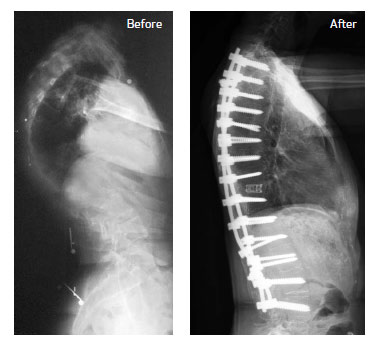
Severe twisting or bending of the spine can cause serious medical problems, especially as patients age. For some patients seen at the Washington University and Barnes-Jewish Spine Care Center, a surgical procedure called vertebral column resection (VCR) may be the answer.
The most common mid-spine deformities include scoliosis, kyphosis, and kyphoscoliosis, a condition that combines both the hump of kyphosis and the twisted corkscrew shape of scoliosis. These conditions put pressure on the ribcage, eventually making it difficult to breathe.
How VCR works
When the deformity becomes severe, the spine is rigid and hard to manipulate. During the VCR procedure, surgeons take the vertebra that is the farthest out of alignment and remove it completely, creating a temporary spinal instability and flexibility. Then they can carefully reconnect, or fuse, the spinal column to straighten it out. To prevent neurologic complications, surgeons continuously monitor the spinal cord’s function during the surgery.
VCR for cervical deformities
Neill Wright, MD, uses VCR to treat patients with severe cervical spine deformities. The results can be just as dramatic as those for back curvature.
“We find that, in addition to trauma, we have two main situations in the cervical spine for which VCR is appropriate,” says Wright. The first, ankylosing spondylitis, is a chronic inflammatory autoimmune disease that causes fusing of the vertebrae. When vertebrae fuse in alignment, patients’ symptoms can be managed without surgery, but in some cases, the neck fuses in a dramatic way.
“One 34-year old man with this condition had an undiagnosed neck fracture that caused his cervical spine to fuse so that his chin rested rigidly on his chest in a fixed looking-down position. VCR was done to remove the broken vertebra and straighten his neck, restoring function,” Wright says.
The other common application, usually seen in older adults, is severe degenerative arthritis, in which the vertebrae degenerate and cause the spine to buckle under the weight of the head. In this condition, the head drops forward but is moveable. “For these patients, we remove bone and shore up the vertebrae to support the head,” Wright says.
The future of VCR
Ian Dorward, MD, a Washington University neurosurgeon and orthopedic surgeon at Barnes-Jewish Hospital, completed a fellowship in spinal surgery. “What makes us truly unique is refining this expertise through the collaboration of orthopedics and neurosurgery,” Dorward says.